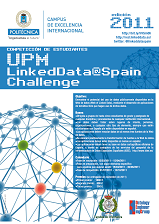| The Web of Linked Data, http://www.w3.org/DesignIssues/LinkedData.html) is an initiative intending both to facilitate the access to data so that they can be published and reused through the Web and to make easier the construction of applications concerning the data thus exposed. One of the greatest differences between the Web of Linked Data and the Web we know at present lies in the fact that it goes beyond publishing documents, that is, HTML pages more or less complex, and it tackles any data capable of being published and reused, such as multimedia content, sensor data, data bases, etc. The fundamental principles of the Web are being applied successfully in all areas of public administrations. Governments such as those of the United Kingdom or the United States (http://data.gov y http://data.gov.uk/) have decided to expose publicly their data following the principles of the Web of Linked Data. In Spain, autonomous communities such as the Basque Country, Catalonia, Asturias, Castile and Aragon, municipal councils such as Saragossa o Gijon, and national entities such as the National Geographic Institute of Spain, the National Library or the Spanish Meteorological Agency have started publishing their data openly and free of charge. Additionally, new laws regarding these issues are being passed to ensure that these initiatives will not be the only ones in the future. Moreover, these recommendations are already been followed by content providers such as the BBC. As a result of these efforts, a great amount of data is now exposed and connected openly, as the Linked Open data initiative reflects in (http://linkeddata.org). The purpose of this international contest is to create original applications that make use of public data from the Web of Linked data. Such applications can be based and available on any platform (Web, mobile phones, etc.). They should demonstrate that their functionalities run smoothly just because they use data publicly available. The main restrictions to enter the contest are the following:
The contest is addressed to student teams, and there is not limit on the number of teams. Free-choice credits are provided for students at the UPM. ScheduleCall for the contest: 1/9/2012 - 31/10/2012 | Download the challenge poster UPM LinkedData@Spain Challenge GroupJoin the Challenge group in Google Groups. To view and join this group, use the following link. |

